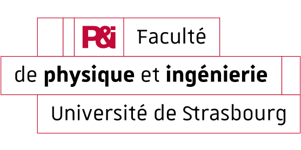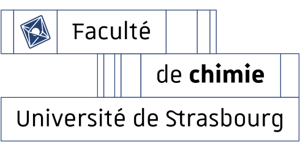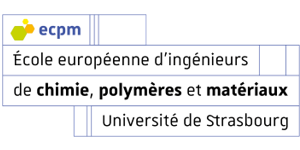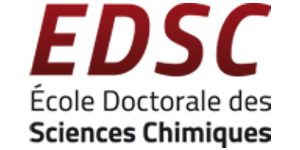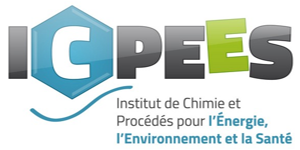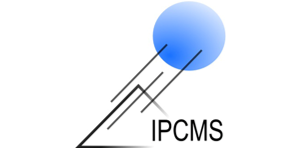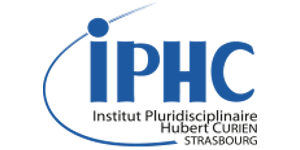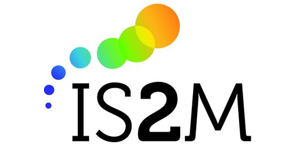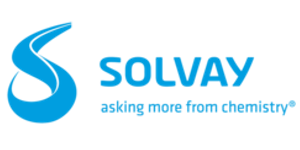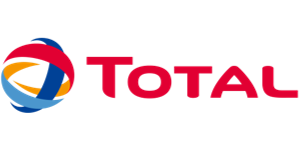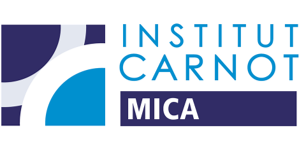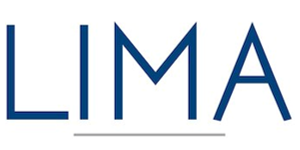Page contents
Last update 2024-08-07
2024
Ben Djemaa, I. et al. Glucono-Delta-Lactone-Induced Alginate Gelation: New Insights into the Effect of the Cross-Linker Carrier Type on the Hydrogel Mechanics. Langmuir40, 10492–10501 (2024).
Delacourt, C., Chemtob, A., Goddard, J. P., Spangenberg, A. & Cormier, M. 3D-Printed Eosin Y-Based Heterogeneous Photocatalyst for Organic Reactions. Chemistry - A European Journal30, (2024).
Farago, J., Jouanlanne, M., Egelé, A. & Hourlier-Fargette, A. Elastic ribbons in bubble columns: when elasticity, capillarity and gravity govern equilibrium configurations. (2024).
Farago, J. & Drenckhan-Andreatta, W. Analytical description of elastocapillary membranes held by needles. Soft Matter20, 4707–4714 (2024).
Figliola, C. et al. Difluoro Dipyridomethene Boron Complexes: Synthesis, Characterization, and Ab Initio Calculations. Journal of Organic Chemistry89, 3020–3032 (2024).
Galland, P. et al. Tuning the underwater adhesiveness of antibacterial polysaccharides complex coacervates. Journal of Colloid and Interface Science661, 196–206 (2024).
Hamann, M. et al. Fluorocarbon-driven pore size reduction in polyurethane foams: an effect of improved bubble entrainment. Colloid and Polymer Science302, 585–596 (2024).
Iqbal, M. H., Kerdjoudj, H. & Boulmedais, F. Protein-based layer-by-layer films for biomedical applications. Chemical Science
vol. 15 9408–9437 at doi.org/10.1039/d3sc06549a (2024).
Jouanlanne, M., Egelé, A., Drenckhan, W., Farago, J. & Hourlier‐Fargette, A. Solidification of Polyurethane Model Foams via Catalyst Drainage from a Secondary Foam. Macromolecular Rapid Communications (2024) doi:10.1002/marc.202400254.
Khitous, A. et al. Spatial Distribution of the Photopolymerization Induced by Localized Surface Plasmons: Impact of the Morphology of the Au Nanoparticles. The Journal of Physical Chemistry C (2024) doi:10.1021/acs.jpcc.4c03148.
Khitous, A. et al. Sol-Gel TiO2 Thin Film on Au Nanoparticles for Heterogeneous Plasmonic Photocatalysis. ACS Applied Materials and Interfaces16, 10856–10866 (2024).
Khitous, A., Vidal, L. & Soppera, O. Optical and photocatalytic properties of sol-gel AuNPs@TiO2 ultrathin film. Applied Surface Science669, (2024).
Khitous, A., Lartigue, L., Moreau, J. & Soppera, O. Insights into Photopolymerization at the Nanoscale Using Surface Plasmon Resonance Imaging. Small (2024) doi:10.1002/smll.202401885.
Niogret, G. et al. A toolbox for enzymatic modification of nucleic acids with photosensitizers for photodynamic therapy. RSC Chemical Biology (2024) doi:10.1039/d4cb00103f.
Pivard, S. et al. Bubbling up in a Lab-on-a-Chip: A gravity-driven approach to the formation of polyelectrolyte multilayer capsules and foams. Colloids and Surfaces A: Physicochemical and Engineering Aspects 134608 (2024) doi:10.1016/j.colsurfa.2024.134608.
Razzaq, W. et al. Simultaneous photo-induced polymerization and surface modification by microfluidic spinning to produce functionalized polymer microfibers: the effect of their surface modification on cell adhesion. RSC Applied Polymers2, 62–70 (2024).
Razzaq, W. et al. Simultaneous photo-induced polymerization and surface modification by microfluidic spinning to produce functionalized polymer microfibers: the effect of their surface modification on cell adhesion. RSC Applied Polymers2, 62–70 (2024).
Stoerkler, T. et al. Stimuli‐Induced Fluorescence Switching in Azine‐Containing Fluorophores Displaying Resonance‐Stabilized ESIPT Emission. Chemistry – A European Journal (2024) doi:10.1002/chem.202402448.
Stoerkler, T. et al. Red-Shifting ESIPT Fluorescence by Site-Specific Functionalization in 2-(2’-hydroxyphenyl)benzazole Derivatives. ChemPhotoChem (2024) doi:10.1002/cptc.202400079.
Stoerkler, T. et al. Experimental and theoretical comprehension of ESIPT fluorophores based on a 2-(2′-hydroxyphenyl)-3,3′-dimethylindole (HDMI) scaffold. Chemical Science15, 7206–7218 (2024).
Wu, X. et al. Surface Modification of 3D-Printed Micro- and Macro-Structures via In Situ Nitroxide-Mediated Radical Photopolymerization. Advanced Functional Materials34, (2024).
2023
Brion, A. et al. Red Light-Responsive Upconverting Nanoparticles for Quantitative and Controlled Release of a Coumarin-Based Prodrug. Advanced Healthcare Materials12, (2023).
Brion, A. et al. Photoactivatable Liposomes for Blue to Deep Red Light-Activated Surface Drug Release: Application to Controlled Delivery of the Antitumoral Drug Melphalan. Bioconjugate Chemistry34, 1304–1315 (2023).
Diarra, C. O., Boero, M., Steveler, E., Heiser, T. & Martin, E. Exciton diffusion in poly(3-hexylthiophene) by first-principles molecular dynamics. Physical Chemistry Chemical Physics (2023) doi:10.1039/d3cp00533j.
Fernandez de Larrinoa, P. et al. Triphenylphosphonium-functionalized N-heterocyclic carbene platinum complexes [(NHC-TPP+)Pt] induce cell death of human glioblastoma cancer stem cells. International Journal of Pharmaceutics641, (2023).
Fessler, F., Sharma, V., Muller, P. & Stocco, A. Entry of Microparticles into Giant Lipid Vesicles by Optical Tweezers. (2023) doi:10.1103/PhysRevE.107.L052601.
Figliola, C. et al. Lysosomes Targeting pH Activable Imaging-Guided Photodynamic Agents. ChemBioChem24, (2023).
Hamann, M. et al. Quantitative investigation of the pore size-reducing effect of perfluorocarbons in polyurethane foaming. 2023, 763–773.
Hamann, M. et al. Directing the pore size of rigid polyurethane foam via controlled air entrainment. Journal of Cellular Plastics2023, 201–214.
Khitous, A., Molinaro, C., Gree, S., Haupt, K. & Soppera, O. Plasmon-Induced Photopolymerization of Molecularly Imprinted Polymers for Nanosensor Applications. Advanced Materials Interfaces10, (2023).
Lin, C.-F. et al. NIR Laser Integration of Photodetector on 3D Printed Chamber for Colorimetric Biosensing. Colorimetric Biosensing. Advanced Materials Technologies2023,.
Schwaller, D., Yilmazer, S., Carvalho, A., Collin, D. & Mésini, P. J. Impact of polymorphism in oleogels of N-palmitoyl-l-phenylalanine. Soft Matter19, 4277–4285 (2023).
Schweitzer, J. et al. Morphology of ultrathin gold and copper coatings thermally evaporated on polydimethylsiloxane elastomers: From isolated nanoparticles to continuous coatings. Thin Solid Films781, (2023).
Steck, K. et al. Fluorocarbon vapors slow down coalescence in foams: influence of surfactant concentration. Polymer Science301, (2023).
Stoerkler, T., Ulrich, G., Laurent, A., Jacquemin, D. & Massue, J. Interplay between Dual-State and Aggregation-Induced Emission with ESIPT Scaffolds Containing Triphenylamine Substituents: Experimental and Theoretical Studies Interplay be-tween Dual-State and Aggregation-Induced Emission with ESIPT Scaffolds Containing Tripheny-lamine Substituents: Experimental and Theoretical Studies. Journal of Organic Chemistry2023,.
Stoerkler, T., Retailleau, P., Ulrich, G., Jacquemin, D. & Massue Heteroaryl-, J. Heteroaryl-Substituted Bis-Anils: Aggregation-Induced Emission (AIE) Derivatives with Tunable ESIPT Emission Color and pH Sensitivity. Chemistry-A European Journal2023,.
Wu, W. et al. Bottom-Up Tunable Broadband Semi-Reflective Chiral Mirrors. Advanced Optical Materials11, (2023).
2022
Ben Djemaa, I. et al. One-Step Generation of Alginate-Based Hydrogel Foams Using CO2 for Simultaneous Foaming and Gelation. Gels8, (2022).
Ginot, G. et al. PEG-in-PDMS drops stabilised by soft silicone skins as a model system for elastocapillary emulsions with explicit morphology control. Journal of Colloid and Interface Science628, 1044–1057 (2022).
Hammoud, L. et al. The role of the gold-platinum interface in AuPt/TiO2-catalyzed plasmon-induced reduction of CO2 with water. Faraday Discussions242, 443–463 (2022).
Jouanlanne, M. et al. Elastocapillary deformation of thin elastic ribbons in 2D foam columns. Soft Matter18, 2325–2331 (2022).
Kirscher, Q., Hajjar-Garreau, S., Grasset, F., Berling, D. & Soppera, O. Deep-UV laser direct writing of photoluminescent ZnO submicron patterns: an example of nanoarchitectonics concept. Science and Technology of Advanced Materials23, 535–546 (2022).
Mokdad, R. et al. Anti-inflammatory effects of free and liposome-encapsulated Algerian thermal waters in RAW 264.7 macrophages. International Journal of Pharmaceutics614, 121452 (2022).
Mokdad, R. et al. Anti-inflammatory effects of free and liposome-encapsulated Algerian thermal waters in RAW 264.7 macrophages. International Journal of Pharmaceutics614, (2022).
Mokdad, R. et al. Formulation and rheological evaluation of liposomes-loaded carbopol hydrogels based on thermal waters. Drug Development and Industrial Pharmacy48, 635–645 (2022).
Razzaq, W., Serra, C. & Chan-Seng, D. Production of Janus/Hecate microfibers by microfluidic photopolymerization and evaluation of their potential in dye removal. Chemical Communications58, 4619–4622 (2022).
Razzaq, W., Serra, C. A. & Chan-Seng, D. Microfluidic Janus fibers with dual thermoresponsive behavior for thermoactuation. European Polymer Journal174, (2022).
Savin, R. et al. Nanohybrid biosensor based on mussel-inspired electro-cross-linking of tannic acid capped gold nanoparticles and enzymes. Materials Advances3, 2222–2233 (2022).
Savin, R., Blanck, C., Benzaamia, N. O. & Boulmedais, F. Optimization of Nanohybrid Biosensors Based on Electro-Crosslinked Tannic Acid Capped Nanoparticles/Enzyme. Molecules27, (2022).
Sharma, V., Marques, C. M. & Stocco, A. Driven Engulfment of Janus Particles by Giant Vesicles in and out of Thermal Equilibrium. Nanomaterials12, (2022).
Stoerkler, T., Laurent, A. D., Ulrich, G., Jacquemin, D. & Massue, J. Influence of ethynyl extension on the dual-state emission properties of pyridinium-substituted ESIPT fluorophores. Dyes and Pigments208, (2022).
Stoerkler, T. et al. Sterically Hindered 2-(2’-Hydroxyphenyl)benzoxazole (HBO) Emitters: Synthesis, Spectroscopic Studies, and Theoretical Calculations. European Journal of Organic Chemistry2022, (2022).
Vauthier, M. & Serra, C. A. Controlled reversible aggregation of thermoresponsive polymeric nanoparticles by interfacial Diels-Alder reaction. Colloids and Surfaces A: Physicochemical and Engineering Aspects648, (2022).
2021
Khitous, A. et al. Plasmonic Au Nanoparticle Arrays for Monitoring Photopolymerization at the Nanoscale. ACS Applied Nano Materials4, 8770–8780 (2021).
Krywko-Cendrowska, A., Marot, L., Mathys, D. & Boulmedais, F. Ion-Imprinted Nanofilms Based on Tannic Acid and Silver Nanoparticles for Sensing of Al(III). ACS Applied Nano Materials4, 5372–5382 (2021).
Patents
Acknowledgements policy
The visibility of the ITI program, and in particular its results in terms of research and training, must be reflected in a common policy of acknowledgement in publications and works.
To this end, please include the following acknowledgement in all scientific publications and books resulting from work carried out under the ITI, in the space provided by the publisher for this purpose:
« Ce travail s’inscrit dans le cadre de l’Institut Thématique Interdisciplinaire des matériaux hiérarchique et fonctionnel, dans les domaines de la santé, de l’environnement, et de l’énergie, du programme ITI 2021-2028 de l’Université de Strasbourg, du CNRS et de l’Inserm. Il a bénéficié du soutien financier de l’IdEx Unistra (ANR-10-IDEX-0002), et du financement au titre du Programme d’Investissement d’Avenir dans le cadre du SFRI-STRATUS (ANR ANR-20-SFRI-0012) ».
« This work of the Interdisciplinary Thematic Institute HiFunMat, as part of the ITI 2021-2028 program of the University of Strasbourg, CNRS and Inserm, was supported by IdEx Unistra (ANR-10-IDEX-0002) and SFRI (STRAT’US project, ANR-20-SFRI-0012) under the framework of the French Investments for the Future Program. »


